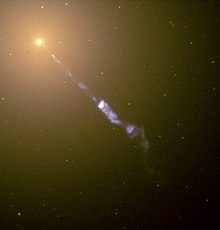Jet (astronomy)

In astronomy, a cosmic jet describes a directed ( collimated ) stream of gas , usually starting from an active galactic core . Some jets can stretch beyond light years and race through space at almost the speed of light .
Emergence
Jets are created when an object accumulates ( accretes ) gas from a rotating disk . Only part of the disk gas reaches the object, the other part flows away from the object perpendicular to the plane of rotation. The collimation comes about either geometrically through the inner edge of the accretion disk or through magnetic fields .
Magnetohydrodynamic processes are important for the formation of jets , although the details are not yet fully understood. Jets are always observed in connection with accretion , the incidence of matter from the circumstellar environment or from a companion star onto a compact star . The angular momentum is effectively dissipated from an accretion disk with a highly collimated magnetic outflow. According to today's conception, the energy and the angular momentum are extracted from the disc by a magnetic torque , which is created by a wound magnetic field in the accretion disc. If the angle of inclination is small enough, magnetic forces can accelerate matter along the field lines . Beyond the Alfvén point , matter is also accelerated by the Lorentz force . The collimation of the jet is achieved by magnetic forces due to the toroidal structure of the magnetic field or by a higher gas pressure in the corona of the accretion disc.
Occurrence
Jets are found in practically all objects accreting from a disk, from black holes (especially in active galactic nuclei ) to just emerging protostars . The jets of quasars can be many thousands of light years long and move at almost the speed of light .
When jets hit dense interstellar matter , shock fronts form . These are called Herbig-Haro objects in the jets of protostars , T-Tauri stars and Herbig-Ae / Be stars .
In stellar astrophysics, jets have also been detected in interacting binary star systems such as symbiotic stars , X-ray binary stars and cataclysmic variables .
Apparent faster than light speed
In the case of jets that move towards the observer at at least 70.7 percent = 1 ⁄ the speed of light and in an angular range between −90 ° and + 90 °, it can even appear to be faster than light . This can be explained in such a way that the light of the approaching jet needs an ever shorter time to reach the observer. As a result, it looks to the observer as if the jet is moving faster than light in a transverse direction.
Jets that do not move in the above-mentioned angular range, i.e. move away from the observer, appear correspondingly slower, since in this case the light has to travel an increasingly longer instead of a shorter path. However, if they move in a purely transverse direction, their real speed can be observed.
radiation
In the case of active galaxies, the clouds are particularly easy to measure in the radio range . Ten active galaxy nuclei (mainly blazars ) were measured by the telescopes EGRET and COMPTEL in the high-energy MeV to GeV range. Various models are discussed to explain the source of this extraordinarily high-energy radiation, including: a. The “low-energy” synchrotron radiation of the jet itself, which is scattered into this energy regime by the inverse Compton effect through collision processes with high-energy jet electrons , or photons that are scattered from the clouds into the jet and there also an inverse Compton scattering to suffer higher energies.
Jets are sources of non-isotropic energy radiation, since jets accelerated to relativistic speed radiate most of the energy in their direction of propagation. According to current hypotheses, both the long gamma ray bursts and the ultra-luminous X-ray sources are not isotropic emitters with energies of up to 10 52 erg (10 45 J ), but emit their proven electromagnetic radiation along a jet axis with an extension of only a few degrees.
Web links
- https://www.spektrum.de/lexikon/astronomie/jet/210
- https://www.mpifr-bonn.mpg.de/473955/suw97
- https://www.scinexx.de/news/kosmos/kosmischer-jet-torpediert-theorie/
- http://www.andromedagalaxie.de/html/agn_modell.htm
literature
- ↑ A. Unsöld, B. Baschek: The new cosmos . Springer Verlag, Berlin 2006, ISBN 978-3-540-42177-1 .
- ↑ Somayeh Sheikhnezami et al .: Bipolar jets launched from magnetically diffusive accretion disks. I. Ejection efficiency vs field strength and diffusivity . In: Astrophysics. Solar and Stellar Astrophysics . 2012, arxiv : 1207.6086v1 .
- ↑ Christian Fendt, Somayeh Sheikhnezami: Bipolar jets launched from accretion disks. II. Formation of symmetric and asymmetric jets and counter jetsn . In: Astrophysics. Solar and Stellar Astrophysics . 2013, arxiv : 1305.1263v1 .
- ↑ L. Hartmann: Accretion Processes in Star Formation (Cambridge Astrophysics) . Cambridge University Press, Cambridge 2008, ISBN 978-0-521-53199-3 .
- ↑ SN Shore, M. Livio, EPJ van den Heuvel, Astrid Orr, H. Nussbaumer: Interacting Binaries: Saas-Fee Advanced Course 22nd Lecture Notes 1992. Swiss Society for Astrophysics and Astronomy (Saas-Fee Advanced Courses) . Springer Verlag, Berlin 1993, ISBN 978-3-540-57014-1 .
- ^ P. Schneider: Introduction to Extragalactic Astronomy and Cosmology . Springer Verlag, Berlin 2007, ISBN 978-3-540-25832-2 .
- ^ Jens Hjorth: The supernova / gamma-ray burst / jet connection . In: Astrophysics. Solar and Stellar Astrophysics . 2013, arxiv : 1304.7736v1 .
- ↑ P. Esposito, SE Motta, F. Pintore, L. Zampieri and L. Tomasella: Swift observations of the ultraluminous X-ray source XMMUJ004243.6 + 412519 in M31 . In: Astrophysics. Solar and Stellar Astrophysics . 2012, arxiv : 1210.5099 .

